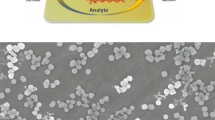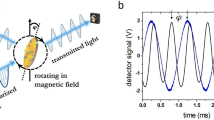Abstract
Molecular imprinting is a technique for preparing polymer scaffolds that function as synthetic receptors1,2,3. Imprinted polymers that can selectively bind organic compounds have proven useful in sensor development2,3,4,5,6,7. Although creating synthetic molecular-imprinting polymers that recognize proteins remains challenging8,9,10,11, nanodevices and nanomaterials show promise in this area12,13,14. Here, we show that arrays of carbon-nanotube tips with an imprinted non-conducting polymer coating can recognize proteins with subpicogram per litre sensitivity using electrochemical impedance spectroscopy. We have developed molecular-imprinting sensors specific for human ferritin and human papillomavirus derived E7 protein. The molecular-imprinting-based nanosensor can also discriminate between Ca2+-induced conformational changes in calmodulin. This ultrasensitive, label-free electrochemical detection of proteins offers an alternative to biosensors based on biomolecule recognition.
This is a preview of subscription content, access via your institution
Access options
Subscribe to this journal
Receive 12 print issues and online access
$259.00 per year
only $21.58 per issue
Buy this article
- Purchase on Springer Link
- Instant access to full article PDF
Prices may be subject to local taxes which are calculated during checkout




Similar content being viewed by others
References
Wulff, G. & Sharhan, A. Über die Anwendung von enzymanalog gebauten Polymeren zur Racemattrennung. Angew. Chem. 84, 364 (1972).
Vlatakis, G., Anderson, L. I., Muller, R. & Mosbach, K. Drug assay using antibody mimics made by molecular imprinting. Nature 361, 645–647 (1993).
Hoshino, Y., Kodama, T., Okahata, Y. & Shea, K. J. Peptide imprinted polymer nanoparticles: a plastic antibody. J. Am. Chem. Soc. 130, 15242–15243 (2008).
Bossi, A., Bonini, F., Turner, A. P. F. & Piletsky, S. A. Molecularly imprinted polymers for the recognition of proteins: the state of the art. Biosens. Bioelectron. 22, 1131–1137 (2007).
Karube, J. et al. Molecular recognition in continuous polymer rods prepared by a molecular imprinting technique. Anal. Chem. 65, 2223–2224 (1993).
Kempe, M. Antibody-mimicking polymers as chiral stationary phases in HPLC. Anal. Chem. 68, 1948–1953 (1996).
Rashid, B. A., Briggs, R. J., Hay, J. N. & Stevenson, D. Preliminary evaluation of a molecular imprinted polymer for solid-phase extraction of tamoxifen. Anal. Commun. 34, 303–305 (1997).
Shi, H., Tsai, W.-B., Garrison, M. D., Ferrari, S. & Ratner, B. D. Template-imprinted nanostructured surfaces for protein recognition. Nature 398, 593–597 (1999).
Rick, J. & Chou, T. C. Using protein templates to direct the formation of thin-film polymer surfaces. Biosens. Bioelectron. 22, 544–549 (2006).
Wang, Y. et al. A potentiometric protein sensor built with surface molecular imprinting method. Biosens. Bioelectron. 24, 162–166 (2008).
Bossi, A., Piletsky, S. A., Piletska, E. V., Righetti, P. G. & Turner, A. P. F. Surface-grafted molecularly imprinted polymers for protein recognition. Anal. Chem. 73, 5281–5286 (2001).
Zheng, G., Patolsky, F., Cui, Y., Wang, W. U. & Lieber, C. M. Multiplexed electrical detection of cancer markers with nanowire sensor arrays. Nature Biotechnol. 23, 1294–1301 (2005).
Yu, X. et al. Carbon nanotube amplification strategies for highly sensitive immunodetection of cancer biomarkers. J. Am. Chem. Soc. 128, 11199–11205 (2006).
Yu, Y. et al. Assembly of multi-functional nanocomponents on periodic nanotube array for biosensors. Micro. Nano. Lett. 4, 27–33 (2009).
Riskin, M., Tel-Vered, R. & Willner, I. The imprint of electropolymerized polyphenol films on electrodes by donor–acceptor interactions: selective electrochemical sensing of N,N′-dimethyl-4,4′-bipyridinium (methyl viologen). Adv. Func. Mater. 17, 3858–3863 (2007).
Lakshmi, D. et al. Electrochemical sensor for catechol and dopamine based on a catalytic molecularly imprinted polymer-conducting polymer hybrid recognition element. Anal. Chem. 81, 3576–3584 (2009).
Panasyuk, T. L., Mirsky, V. M., Piletsky, S. A. & Wolfbeis, O. S. Electropolymerized molecularly imprinted polymers as receptor layers in capacitive chemical sensors. Anal. Chem. 71, 4609–4613 (1999).
Choong, C. L., Bendallb, J. S. & Milnea, W. I. Carbon nanotube array: a new MIP platform. Biosen. Bioelectron. 25, 652–656 (2009).
Wei, Y., Qiu, L., Owen, C. & Lai, E. P. C. Encapsulation of quantum dots and carbon nanotubes with polypyrrole in a syringe needle for automated molecularly imprinted solid phase pre-concentration of ochratoxin A in red wine analysis. Sens. Instrum. Food Qual. 1, 133–141 (2007).
Xie, C., Li, H., Li, S., Wu, J. & Zhang, Z. Surface molecular self-assembly for organophosphate pesticide imprinting in electropolymerized poly(p-aminothiophenol) membranes on a gold nanoparticle modified glassy carbon electrode. Anal. Chem. 82, 241–249 (2010).
Tabard-Cossa, V., Trivedi, V., Wiggin, M., Jetha, N. N. & Marziali, A. Noise analysis and reduction in solid-state nanopores. Nanotechnology 18, 305505 (2007).
Gong, K., Chakrabarti, S. & Dai, L. Electrochemistry at carbon nanotube electrodes: is the nanotube tip more active than the side wall? Angew. Chem. Int. Ed. 47, 5446–5450 (2008).
Bartlett, P. N., Tebbutt, P. & Tyrrell, C. H. Electrochemical immobilization of enzymes. 3. Immobilization of glucose oxidase in thin films of electrochemically polymerized phenols. Anal. Chem. 64, 138–142 (1992).
Klee, C. B. Conformational transition accompanying the binding of Ca2+ to the protein activator of 3′,5′-cyclic adenosine monophosphate. Biochemistry 16, 1017–1024 (1977).
Crouch, T. H. & Klee, C. B. Positive cooperative binding of calcium to bovine brain calmodulin. Biochemistry 19, 3692–3698 (1980).
Weinstein, H. & Mehler, E. L. Ca2+-binding and structural dynamics in the functions of calmodulins. Annu. Rev. Physiol. 56, 213–236 (1994).
Devanathan, S. et al. Subpicomolar sensing of δ-opioid receptor ligands by molecular-imprinted polymers using plasmon-waveguide resonance spectroscopy. Anal. Chem. 77, 2569–2574 (2005).
Patolsky, F., Zheng, G. & Lieber, C. M. Fabrication of silicon nanowire devices for ultrasensitive, label-free, real-time detection of biological and chemical species. Nature Protoc. 1, 1711–1724 (2006).
Sanchez-Carbayo, M. Antibody arrays: technical considerations and clinical applications in cancer. Clin. Chem. 52, 1651–1659 (2006).
Acknowledgements
The authors acknowledge financial support from The Seaver Institute (T.C.C and M.J.N.). L.R. was supported by the China Scholarship Council (no. 2008677005). We thank O. Gursky and S. Jayaraman (Boston University School of Medicine, Department of Physiology and Biophysics) for use of their Aviv spectropolarimeter.
Author information
Authors and Affiliations
Contributions
D.C. contributed to the original MI nanosensor concept, overall experimental design, data analysis, manuscript preparation and directing of the measurements. L.R. was responsible for the EIS recordings and contributed to sensor fabrication. H.Z. fabricated the nanotube arrays. C.X. was responsible for protein preparation and purification. Y.Y. contributed to development of the PPn nanocoating. H.W. and Y.L. helped with the high-resolution TEM image. M.F.R. was responsible for the circular dichroism measurements. L.Z. and J.H.C. were responsible for computational analysis of the interaction between the E7 protein and PPn. M.J.N. provided technical support for nanotube fabrication and assisted in manuscript editing. Z.R. contributed expertise regarding nanotube fabrication, experimental design for TEM evaluation of hFtn entrapment, and editing of the manuscript. T.C.C. contributed to the design of experiments for demonstrating nanosensor selectivity and was responsible for writing and editing the revised manuscript.
Corresponding author
Ethics declarations
Competing interests
The authors declare no competing financial interests.
Supplementary information
Supplementary information
Supplementary information (PDF 1215 kb)
Rights and permissions
About this article
Cite this article
Cai, D., Ren, L., Zhao, H. et al. A molecular-imprint nanosensor for ultrasensitive detection of proteins. Nature Nanotech 5, 597–601 (2010). https://doi.org/10.1038/nnano.2010.114
Received:
Accepted:
Published:
Issue Date:
DOI: https://doi.org/10.1038/nnano.2010.114
This article is cited by
-
A surface protein−imprinted biosensor based on boronate affinity for the detection of anti−human immunoglobulin G
Microchimica Acta (2022)
-
Immunosensors for Biomarker Detection in Autoimmune Diseases
Archivum Immunologiae et Therapiae Experimentalis (2017)
-
Potentiometric detection of chemical vapors using molecularly imprinted polymers as receptors
Scientific Reports (2015)



